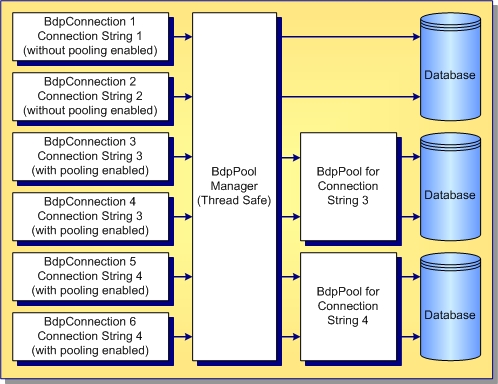|
RAD Studio for Microsoft .NET
|
|
RAD Studio for Microsoft .NET
|
In most cases, the AdoDbxClient Provider provides the best database connectivity solution for your .NET applications. However, if you are developing new VCL Forms applications for the .NET Framework, or you are migrating existing Win32 VCL Forms applications to the .NET Framework, RAD Studio provides continued support for existing Delphi database technologies.
RAD Studio provides a migration path from Delphi database technologies running strictly on Win32 clients to the .NET Framework. In addition to being able to build new database applications using ADO.NET, you can migrate existing database applications to take advantage of .NET capabilities. The Delphi database technologies now supported by RAD Studio include:
RAD Studio includes a .NET version of dbExpress. This set of components provide comparable functionality as the dbExpress components for Win32, but updated to run on VCL Forms on the .NET Framework. dbExpress for .NET provides the same lightweight client capability and unidirectional dataset that is available in previous versions of the product.
RAD Studio provides the means to use the DataSnap (DCOM) client to connect to databases in three-tier applications.
RAD Studio provides you with access to InterBase databases, by way of InterBase Express controls, in addition to the standard BDP.NET data adapter or the .NET Framework's ADO.NET providers. IBX.NET controls allow you to connect to InterBase databases, access tables, etcetera.
AdoDbx is a data-access mechanism that can be shared by several applications. AdoDbx defines a powerful library of API calls that can create, restructure, fetch data from, update, and otherwise manipulate local and remote database servers. Adoprovides a uniform interface to access a wide variety of database servers, using drivers to connect to different databases.
You can connect your RAD Studio database applications to BDE-supported databases, such as Paradox and dBase.
RAD Studio includes a .NET version of dbGo. This set of components provides comparable functionality as the dbGo components for Win32, but updated to run on VCL Forms on the .NET Framework. dbGo for .NET provides the same powerful and logical object model that is available in previous versions of the product.
|
Name |
Description |
|
You can use the connection pooling options to save connection time by using a connection from an existing pool. When you are using BDP, all connections go through the BDP Pool Manager, even if pooling is not enabled for your connection. For each connection, you can specify: Pooling (enabled or disabled), Minimum Pool Size, Maximum Pool Size, whether connection requests should Grow On Demand, and the number of seconds before a Connection Timeout (or number of seconds for Connection Lifetime).  As shown in the diagram above, the BDP Pool Manager creates a separate pool for each unique connection string.... more | |
|
dbExpress is a set of lightweight database drivers that provide fast access to SQL database servers. For each supported database, dbExpress provides a driver that adapts the server-specific software to a set of uniform dbExpress interfaces. When you deploy a database application that uses dbExpress, you might need to include a DLL (the server-specific driver) with the application files you build. For example, DbxClient is a 100% Delphi driver and needs no DLL. dbExpress lets you access databases using unidirectional datasets. Unidirectional datasets are designed for quick lightweight access to database information, with minimal overhead. Like other datasets, they can... more | |
|
dbGo provides the developers with a powerful and logical object model for programmatically accessing, editing, and updating data from a wide variety of data sources through Microsoft ADO system interfaces. The most common usage of dbGo is to query a table or tables in a relational database, retrieve and display the results in an application, and perhaps allow users to make and save changes to the data. The ADO layer of an ADO-based application consists of the latest version of Microsoft ADO, an OLE DB provider or ODBC driver for the data store access, client software for the specific database... more |
|
Copyright(C) 2008 CodeGear(TM). All Rights Reserved.
|
|
What do you think about this topic? Send feedback!
|